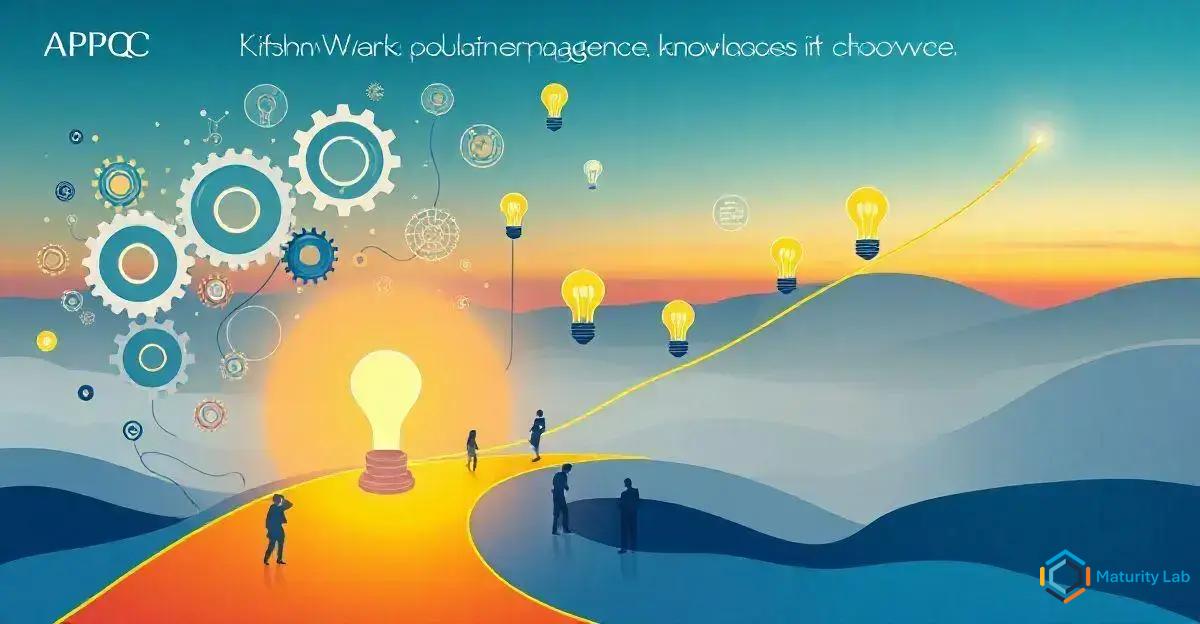The APQC Knowledge Management Maturity Model provides a framework for organizations to evaluate and enhance their knowledge management practices through five levels: Initial, Repeatable, Defined, Managed, and Optimized. By assessing their current state, setting goals, and creating an implementation plan, organizations can improve efficiency, foster innovation, and gain a competitive edge, while integrating knowledge management with business processes and promoting a culture of continuous learning and knowledge sharing.
In today’s fast-paced business environment, the ability to manage knowledge effectively is crucial for fostering organizational innovation. The APQC Knowledge Management Maturity Model offers a structured approach to evaluating and enhancing knowledge management practices within an organization. By leveraging this model, companies can identify areas for improvement, streamline processes, and ultimately drive innovation. In this article, we will explore the intricacies of the APQC Knowledge Management Maturity Model and provide practical insights on how to implement it to achieve organizational excellence.
Understanding the APQC Knowledge Management Maturity Model

The APQC Knowledge Management Maturity Model is a comprehensive framework designed to help organizations assess and improve their knowledge management practices. This model is structured around five maturity levels, each representing a different stage of knowledge management capability and sophistication. These levels are: Initial, Repeatable, Defined, Managed, and Optimized.
At the Initial level, knowledge management practices are typically ad hoc and unstructured. Organizations at this stage may rely heavily on individual expertise and informal networks, leading to inconsistencies and inefficiencies. Moving to the Repeatable level, organizations begin to establish basic processes and standards for knowledge management, but these practices are not yet fully integrated or consistently applied across the organization.
The Defined level marks a significant advancement, as organizations develop standardized knowledge management processes and policies. At this stage, there is a clear commitment to knowledge management, with dedicated resources and formalized roles and responsibilities. The Managed level builds on this foundation by introducing metrics and performance indicators to monitor and evaluate the effectiveness of knowledge management initiatives. Organizations at this level use data-driven insights to continuously improve their practices.
Finally, the Optimized level represents the pinnacle of knowledge management maturity. Organizations at this stage have fully integrated knowledge management into their strategic objectives and operational processes. They leverage advanced technologies and methodologies to foster a culture of continuous learning and innovation. Knowledge management is not just a function but a core component of the organization’s DNA.
Understanding the APQC Knowledge Management Maturity Model is essential for organizations seeking to enhance their knowledge management capabilities. By identifying their current maturity level and setting clear goals for progression, companies can systematically improve their practices, leading to greater efficiency, innovation, and competitive advantage. Wouldn’t it be more efficient to implement an action plan to enhance your company’s maturity after understanding its current maturity level?
Implementing the APQC Model for Organizational Innovation

Implementing the APQC Knowledge Management Maturity Model to drive organizational innovation involves a strategic and systematic approach.
The first step is to conduct a thorough assessment of the current state of knowledge management within the organization. This involves evaluating existing processes, technologies, and cultural attitudes towards knowledge sharing and utilization. Tools such as surveys, interviews, and document reviews can be employed to gather comprehensive data.
Once the assessment is complete, the organization can identify its current maturity level according to the APQC model. This baseline understanding is crucial for setting realistic and achievable goals. For instance, if an organization is at the Initial level, the focus might be on establishing basic knowledge management processes and fostering a culture of knowledge sharing. Conversely, organizations at the Defined level might aim to refine their processes and introduce performance metrics.
The next step is to develop a detailed implementation plan.
This plan should outline specific actions, timelines, and responsibilities for advancing to the next maturity level. Key components of the plan may include process standardization, technology upgrades, and training programs. It is essential to secure buy-in from leadership and ensure that all stakeholders understand the benefits of improved knowledge management practices.
To foster organizational innovation, the implementation plan should also emphasize the integration of knowledge management with other business processes. This could involve aligning knowledge management initiatives with strategic objectives, such as product development, customer service, or operational efficiency. By embedding knowledge management into the fabric of the organization, companies can create a culture of continuous learning and improvement.
Monitoring and evaluation are critical components of the implementation process. Organizations should establish metrics and performance indicators to track progress and measure the impact of knowledge management initiatives. Regular reviews and adjustments to the implementation plan ensure that the organization remains on track to achieve its maturity goals.
In conclusion, implementing the APQC Knowledge Management Maturity Model requires a methodical approach, but the rewards in terms of enhanced innovation and competitive advantage are well worth the effort. By systematically improving their knowledge management practices, organizations can unlock new opportunities for growth and success. Wouldn’t it be more efficient to implement an action plan to enhance your company’s maturity after understanding its current maturity level?
In conclusion, the APQC Knowledge Management Maturity Model serves as a vital tool for organizations striving to enhance their knowledge management capabilities and drive innovation.
By understanding the various maturity levels and conducting a thorough assessment of their current state, companies can set clear, achievable goals for improvement.
Implementing the model involves a strategic approach that includes developing a detailed action plan, securing leadership buy-in, and integrating knowledge management with broader business processes.
The journey towards higher maturity levels
is marked by continuous monitoring, evaluation, and adjustment of strategies.
Organizations that commit to this systematic improvement process can expect to see significant benefits, including increased efficiency, enhanced innovation, and a stronger competitive position in the market.
The APQC model not only provides a roadmap for improvement but also fosters a culture of continuous learning and knowledge sharing, which are essential for long-term success.
Ultimately, the APQC Knowledge Management Maturity Model offers a structured pathway for organizations to transform their knowledge management practices and achieve excellence.
By leveraging this model, companies can unlock new opportunities for growth and innovation, ensuring they remain agile and competitive in an ever-evolving business landscape.
Wouldn’t it be more efficient to implement an action plan to enhance your company’s maturity after understanding its current maturity level?
Frequently Asked Questions about the APQC Knowledge Management Maturity Model
What is the APQC Knowledge Management Maturity Model?
The APQC Knowledge Management Maturity Model is a framework designed to help organizations assess and improve their knowledge management practices across five maturity levels: Initial, Repeatable, Defined, Managed, and Optimized.
How can the APQC model enhance organizational innovation?
By systematically improving knowledge management practices, the APQC model helps organizations streamline processes, foster a culture of continuous learning, and integrate knowledge management with strategic objectives, thereby driving innovation.
What are the key steps in implementing the APQC Knowledge Management Maturity Model?
Key steps include conducting a thorough assessment of current knowledge management practices, identifying the current maturity level, developing a detailed implementation plan, securing leadership buy-in, and integrating knowledge management with broader business processes.
Why is it important to assess the current state of knowledge management?
Assessing the current state helps organizations understand their strengths and weaknesses, set realistic goals for improvement, and create a targeted action plan to advance their knowledge management maturity.
What role does leadership play in implementing the APQC model?
Leadership plays a crucial role in securing buy-in, allocating resources, and fostering a culture that values knowledge sharing and continuous improvement, which are essential for successful implementation.
How can organizations measure the success of their knowledge management initiatives?
Organizations can measure success by establishing metrics and performance indicators to track progress, regularly reviewing and adjusting their implementation plan, and evaluating the impact of knowledge management initiatives on efficiency, innovation, and competitive advantage.

